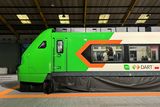Microsoft: Windows 10 already installed on 14 million computers
US Software giant Microsoft showcasing Windows 10 during a launch event in Seoul, Korea
MICROSOFT Windows 10 has already been installed on 14 million computers, just hours after its launch. And the number could be bigger as Microsoft is delivering the latest update in phases to ensure a smooth rollout.
"While we now have more than 14 million devices running Windows 10, we still have many more upgrades to go before we catch up to each of you that reserved your upgrade," Yusuf Mehdi, Microsoft's corporate vice president said in a blog.
Following a hostile reception to Windows 8 in 2012, which was only placated in small part by the Windows 8.1 update in 2013, Microsoft is hoping that Windows 10 can help it regain favour among its 1.5 billion daily users.
Windows 10 rights a lot of the wrongs done by Microsoft in Windows 8. One of the things that people hated about Windows 8 was the feeling that they were constantly being pushed to use "live tiles", which were designed for touch-based computing, even when they were using a traditional desktop set-up with a keyboard and mouse.
Another was the removal of the Start menu, which many people relied on as their first point of access to all software.
This was replaced in Windows 8.1 with a Start button in the bottom left hand corner of the screen, but rather than opening up a navigation menu, it launched the tile-based touch user interface that most people were trying to escape.
Although live tiles are still a feature of Windows 10, they are not nearly as obtrusive. When you open up the new Start menu, there is a panel of live tiles on the right, where people can "pin" their favourite apps, but there is also a traditional Windows 7-style Start menu on the left, that allows users to sort through all of their files, apps and settings systematically.
More importantly, clicking on a live tile does not result in you being transported to another virtual universe where the app takes over your entire screen and it feels impossible to escape, as it did in Windows 8. Rather, it opens in a neat little window on your desktop, and generally behaves in a much more intuitive way.
Within this context, live tiles seem less repellent than they did in Windows 8. They blend much more into the wider user experience in desktop mode, and if you really can't stand the sight of them in your Start menu, you can unpin them all, and you will be left with just the list menu on the left hand side.
The advantage of having them, of course, is that if you're using a convertible device that operates in both desktop and tablet mode, then applications downloaded from the Windows Store will automatically adjust themselves to suit the mode, making switching between the keyboard and touch interface feel seamless.
So if you're working on an Office Word document at your desk and then have to go and catch a train, you can switch to tablet mode and carry on working on the same document in touchscreen mode as soon as you get a seat.
Microsoft has replaced the despised "Charms" bar from Windows 8, which appears when you swipe or click on the right hand side of the screen, with an "Action Center" that provides notifications and quick access to settings, and is genuinely quite useful.
What Windows 7 users, in particular, will like about Windows 10 is the speed and responsiveness of the new system. Given that Windows 7 is now six years old, the software inevitably feels a bit clunky, but it is really noticeable that programs start faster and run faster in Windows 10, and the whole system feels more slick.
For those who stopped using Internet Explorer years ago, Microsoft's new web browser, Edge, is a revelation.
It feels more like the Google Chrome browser, with a light, stripped-back user interface and a simple set of tools along the top, under the search bar.
For example, "favourites" lets you bookmark a page and cache it for reading offline, "web note" lets you annotate live pages and then save a screenshot of the page, and "share page" lets you send a link to friends via email or social network.
Read mode is also great for people who like to read long articles online, allowing you to strip out all the ads, and sidebars, pop-ups and links, and scroll through a single column of text and pictures. You can't use it on every page, and you still have to go back to the standard layout in order to navigate, but it's a really nice user-friendly feature. Cortana, Microsoft's virtual personal assistant, is integrated into Windows 10, and appears as a search box on the task bar. You can either type queries into the search box or issue voice commands by saying "Hey Cortana," and then asking a question.
If you give Cortana access to your email and calendar clients, for example, it can start to act more like a real personal assistant, extracting relevant information and proactively offering information.
So, in theory, if you have been discussing a particular airline flight in an email, and that flight is delayed, Cortana will alert you to the delay. Or of you have a meeting across town and there is heavy traffic, it will tell you when you need to leave to avoid being late.
The idea is that, over time, Cortana gets to know more about you and becomes better at pushing the right information to you at the right time.
There are, of course, many other features in Windows 10, like the ability to run multiple "desktops" side by side, which is the virtual equivalent of having multiple PC monitors with different apps open on each screen. It's quite a niche feature, but one that some people will no doubt find useful.
You can also "snap" applications that are open to different corners of the screen to make them easier to view. (Sophie Curtis, © Daily Telegraph, London)
Join the Irish Independent WhatsApp channel
Stay up to date with all the latest news














